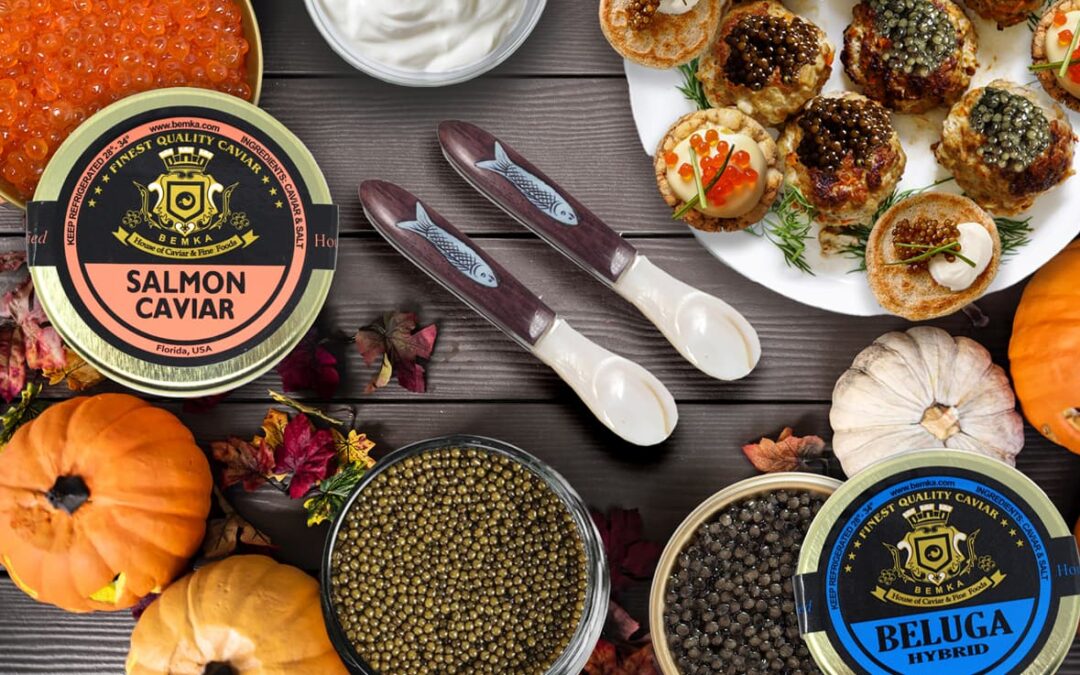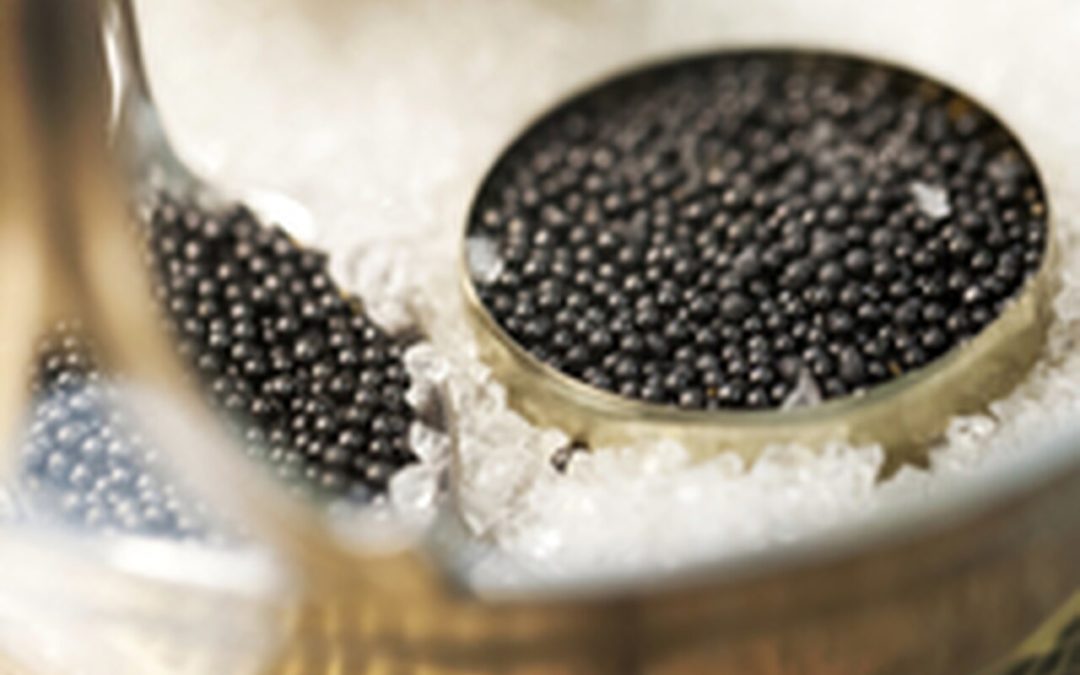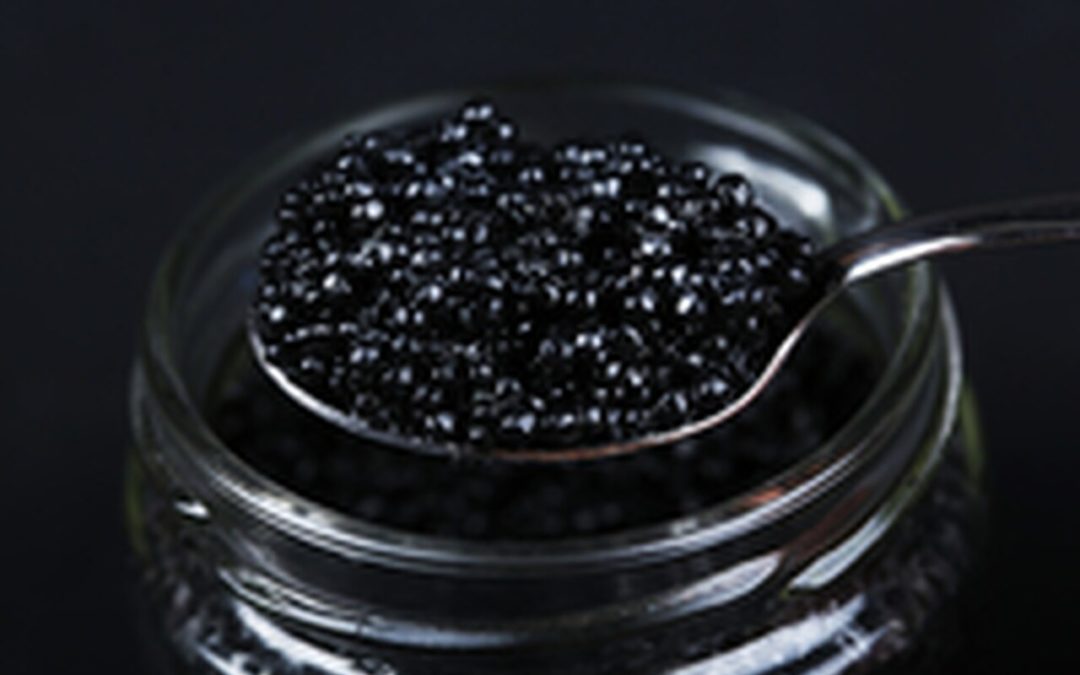
by HOCAFF Team | Oct 11, 2021 | General
It’s Halloween month! and what are you cooking? Pumpkins? We all love pumpkins for Halloween but have you ever tried Caviar? Yes! This year take a chance for trying new recipes and surprise your family, friends, or guests. Caviar is one of the top delicacies in the world, some people think Caviar can only be eaten at fancy restaurants but this is a huge myth. All types of Caviar – Imported or domestic- are available to shop online and be delivered to your home. So, for this Halloween make sure to use Caviar in your recipes. There’s no excuse!
Before going ahead with the recipe’s ideas, let’s remember which types of Caviar exist so you can decide which one you would like to try for this event. Caviar is eggs or roe collected from the sturgeon family, traditionally sourced from the Caspian and Black Seas. There are many types of Caviar but you should know there are two main categories: Imported and Domestic. When Caviar comes from its original source in Europe this product is Imported Caviar and its most recognized types are: Ossetra, Beluga and Kaluga. When Caviar is farmed and produced in the United States, it is called Domestic Caviar. This type of Caviar is known for being more affordable without losing the Caviar experience. Try Paddlefish Caviar or Hackleback Caviar and find it out for yourself. At last, there’s still one more option: Fish Roe. When we say roe, we are referring to all unfertilized eggs collected from marine animals. Salmon roe and the roe from whitefish, trout, cod, red caviar, ikura, and tobiko, etc. are considered “Caviar substitutes” and not Caviar. No matter which type of Caviar you choose, they’re all available in our online store. Visit House of Caviar and discover our selection of the greatest quality Caviar picked especially for you!

Now it’s time to cook!
These are three recipe ideas for you to try this Halloween using Caviar. Make sure to buy your favorite and the rest is up to you, be creative and enjoy.
Halloween Caviar Crackers

Ingredients:
- Tortillas
- Melted Butter
- Crème fraiche
- Halloween cookie cutters
- Salmon Roe or Caviar
Preheat your oven to 350 degrees and put it on a conventional bake. Using your cookie cutter, cut out as many shapes as you can from your tortillas. Use the melted butter to lightly coat tortillas. Cook for 5-10 minutes or until golden brown. Once your tortillas have cooled, add a dollop of crème fraiche and carefully place a spoonful of Caviar on top. Serve immediately and Happy Halloween!
Sweet Potatoes with Caviar

Ingredients:
- 2 Sweet Potatoes
- 2 Tablespoons of chopped Chives
- 1/4 cup of Crème Fraîche
- Caviar
Slice 2 sweet potatoes into 1/8-inch-thick rounds. Brush with olive oil and season with salt and pepper. Bake at 425 degrees F° until crisp, about 15 minutes, then cool on a rack. Mix 2 tablespoons chopped chives with 1/4 cup Crème Fraîche. Dollop on the potatoes and top with Caviar.
Four-Layer Caviar Dip

Ingredients:
- 6 large hard-cooked eggs, chopped
- 2 tablespoons sour cream
- 2 tablespoons mayonnaise
- 1/2 teaspoon kosher salt
- Cooking spray
- 1 cup finely chopped red onion, rinsed and dried
- 8 ounces cream cheese, softened
- 1/3 cup thinly sliced fresh chives
- 2 ounces Black Caviar (such as Paddlefish)
- Water crackers
Stir together chopped eggs, sour cream, mayonnaise, and salt in a medium bowl. Lightly grease a 6-inch ring mold with cooking spray. Spoon egg mixture evenly on the bottom of prepared ring mold. Top evenly with onion. Stir together cream cheese and chives in a bowl, and gently spread over onion; top with Black Caviar. Refrigerate for 2 hours. Unmold onto a serving plate or platter, and serve with crackers.
These recipes can be served as appetizers for a private party or family reunion. Which one was your favorite? If you want to keep digging on recipe ideas check Food and Wine, Food Network, or Yummly. And remember the best way to get Caviar is to buy it in a reputable store. Visit House of Caviar and discover our variety of fine food products. We’ll be looking forward to seeing you!

by HOCAFF Team | Aug 19, 2016 | General
Why is Beluga Caviar restricted or illegal to buy or sell in the United States? In short, because the Beluga sturgeon where the caviar eggs come from is critically endangered, so there are laws set to protect these endangered species. Do not be alarmed; although Beluga caviar is one of the most recognized caviar, there are many other types of caviar that have similar qualities and can even be considered tastier or of higher quality than Beluga caviar that you’ll be sure to want to try instead. For a more explanatory description of why Beluga caviar is illegal to buy this delicacy as well as Beluga Caviar substitutes, please read on.
Restriction of Beluga Caviar Trade
The glossy black eggs of the Beluga caviar are as elusive as they are pricey. The traditional source of this classic delicacy is from the sturgeons in the Caspian and Black Sea. Over the years, as the demand for Beluga Caviar increased however, overfishing and environmental effluence threatened the survival of these primordial fish. According to data from the Caviar Emptor environmental coalition, between 2004 and 2005, the sturgeon stock in that region, declined by as much as 45%. As a result, caveats from concerned marine biologist and environmentalist led to restrictions and bans on the production, importation and sale of Beluga Caviar.
Although the ban has been lifted by the United Nations for some sources of Beluga Caviar, under the Endangered Species Act, it is illegal to buy Beluga caviar in the United States. Not surprisingly, these constraints have severely restricted the average individual’s ability to buy this highly favored luxury food.
These restrictions have also resulted in:
- Driving up the cost of available Beluga Caviar.
- Diminishing the number of potential consumers of this variety.
- Expanding the production of farm-raised sturgeons; and
- Forcing regular caviar consumers to consider other, sometimes less pricey substitutions such as Kaluga, Ossetra or the American Hackleback Caviar.
Unique Beluga Caviar Substitutes
Most caviar purists will assert that, the Beluga Caviar is the rarest, most sumptuous and expensive delicacy in the world today. And, while they will no doubt protest, there are other caviars that closely mimic the delicate and exquisite redolence of the Beluga Caviar. In fact, some avid caviar connoisseurs have even gone so far as to confess to having a preference for another caviar variety over the highly relished Beluga Caviar.
Whether you are craving Beluga Caviar or your recipe calls for it and it is simply out of your reach at the moment, why not try one of the following Beluga Caviar substitutes.
Kaluga Caviar
Although there is a difference between the color of the Beluga and the Kaluga Caviar selection, this is pretty much where any major distinction ends. In comparison to the gray to almost black roes of the Beluga Caviar, the Kaluga Caviar can vary in appearance from golden to a medium or dark brown. The clear glossy finish of the large eggs and the delicate, buttery flavor of Kaluga Caviar however, closely mimics it’s hard to find, excessively expensive counterpart. Not surprisingly, Kaluga Caviar is usually the most selected option because of its flavor similarities to Beluga Caviar. As such, Kaluga Caviar is a great choice when looking for a substitute for Beluga Caviar.
Ossetra Caviar
Next to Beluga and Kaluga, Ossetra Caviar is one of the most esteemed and costly types of caviar. The Ossetra sturgeon can live up to 50 years and weigh as much as 400 pounds. High quality farm-raised Ossetra sturgeons supports the demand for the endangered Caspian population. Ossetra caviars also vary in color from golden to deep brown. However, the rich, robust flavor of the lighter Ossetra variety are typically the most sought after. In addition, the range of the Ossetra Caviar selection makes it a viable substitute to Beluga Caviar since it provides more flavor offerings. The varieties include Russian Ossetra Caviar, Siberian Ossetra and Golden Imperial Ossetra to name a few. Like any other high quality caviars like Beluga, Kaluga Caviar is typically served on blinis with crème fraiche as opposed to being stuffed into seafood dishes like cheaper versions.
Hackleback Caviar
Although Hackleback Caviar may seem like an unlikely option next to the pricey Beluga, Kaluga and the Ossetra varieties, don’t miss out on the potential inherent in this affordable substitution. For centuries, American Hackleback has been exported to Europe and Asia. In fact, the sweet and buttery flavor of the Hackleback so closely resembles its European equivalent in both appearance and taste, that this caviar is a staple in the kitchen of many world renowned chefs.
When looking to purchase the highest quality of Caviar, such as Kaluga, Ossetra, or Hackleback Caviar, find the best at House Of Caviar and Fine Foods by shopping online , or for their expertise in choosing your selection of Caviar, call 954.462.0533.

by HOCAFF Team | Jul 15, 2016 | General
Learn the Origins of Your Favorite Delicacy: The History of Caviar
Long before Caviar became affiliated with royalty, it was part of the diet in areas where Sturgeon fish was in great abundance. Although accounts of the history of Caviar does not pin a specific date on when the epicurean value of this decadent cuisine began, some records date as far back as pre-historic times.
In essence, caviar is a decadent preparation of the unfertilized eggs or roe of a sturgeon fish. Based on some accounts, caviar is actually the variant of the Persian word “khaya-dar” which means having eggs or egg bearing fish. The Persians who collected the fish eggs for their perceived medicinal value may also have been the first to prepare and appreciate their unique piquancy. However, the tradition of salting roe originated with the Chinese who used this method to preserve Carp eggs.
Ancient classical literature contains several references about caviar. Aristotle who lived during the 4 th Century B.C. spoke so highly of the Sturgeon fish eggs that it became a consummate offering at banquets. Since Sturgeons were found mainly in the Caspian Sea and Black Sea, it was the Russian Tsars that launched its popularity as an opulent epicurean delight. Its status was also significantly heightened towards the end of the 1800s, when the French started importing caviar from Russia, such as Beluga Caviar. In order to preserve the roe for transporting purposes however, the delicate eggs were heavily salted and packed into wooden crates. Despite the fact that these crude processing methods belied the quality of the end product, through consistent demand, Caviar, managed to continue its evolution as a highly sought after and pricey fare. At one point in Britain’s history, Sturgeons were reserved exclusively for the kings and elite of that society and was even knighted as the “Royal Fish”.
Still, at one point in American history, a serving of caviar was sold for a nickel in fine restaurants. Even more unbelievable, this salty delicacy was at times given to saloon patrons to encourage spending on liquor. The proliferation of Sturgeon in the Delaware River eventually spurred the development of a caviar business in 1873 by a German immigrant by the name of Henry Schacht. Soon Schacht began exporting Caviar throughout the world, including to Russia, for a mere dollar a pound. By the end of the 19th century, the United States was producing approximately 90% of the world’s caviar.
Today, this ultimate luxury food is available in a range of prices and varieties. Although the best caviar is a matter of preference, experts say quality is determined by handling and a number of other variables such as maturity of the eggs, texture, color and depth of flavor.
Topping the list of most expensive and well known (yet restricted to sell in the US) is the Beluga Caviar. Although not all Caviar lovers will agree that this is the best of the best, it definitely commands the highest price. Beluga Caviar along with Sevruga and Ossetra are considered to be the most sought after and expensive Caviar. However, overfishing has depleted and endangered the Caspian Sea Sturgeon population, which has made Beluga Caviar illegal to import to the USA. As the Beluga becomes less available, it has created a growing demand for Golden Imperial Ossetra or Kaluga Caviar . Experts say the Kaluga roe is an exquisite substitute that is similar in appearance and flavor to Beluga Caviar. The selection of Kaluga Caviar comes from the Huso Daricus Sturgeon and Amur Sturgeon eggs. Most importantly for many of today’s consumer, it is a sustainable product.
The fall off of supply of Caviar from the Caspian and Black Sea has also expanded interest and the market for other types of fish roe including Hackleback, Royal White Sturgeon , Paddlefish, Bowfin, trout and salmon, amongst others. For instance, the sweet buttery and nutty flavor of the Hackleback Caviar is similar to Caspian Ossetra. As such, as caviar lovers expanded their palate, many consider domestic caviars to be an appealing and affordable alternative to their international counterparts.







